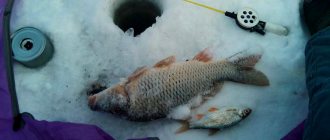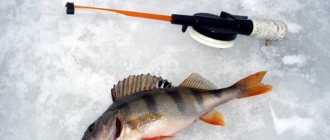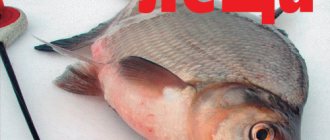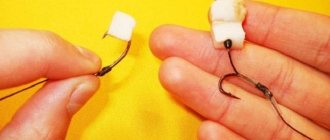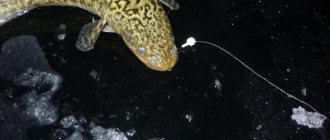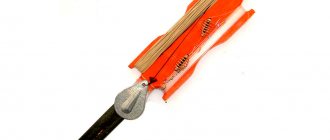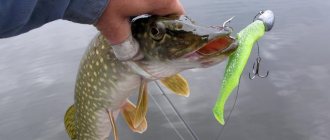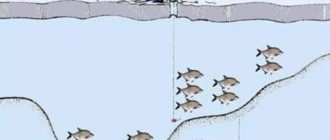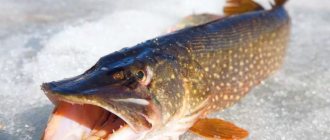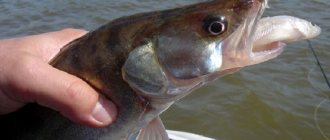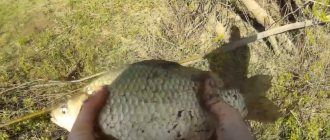With the arrival of winter, fishing enthusiasts do not have to get bored, since on reservoirs covered with ice and snow they still have something to do and enjoy. During this season, only the fishing conditions change, a certain gear is used, and the fish bite only those that have not fallen into deep winter hibernation, but continue to be awake. 34fish.ru invites you to go fishing!
This method of fishing, like rolling, does not require any special or tricky gear, and the technique of such fishing can be quickly and easily mastered. This method is especially good and effective when catching river whitefish (bream, carp, crucian carp, roach, etc.); perch and pike perch are also caught using this tackle.
Ride structure design
There are several equipment schemes. The modification is chosen taking into account fishing conditions and the type of intended prey. For active fishing, a bamboo, wood or plastic fishing rod is suitable. A sliding spherical sinker is attached to the base. For fixation, use a silicone stopper.
For a static fishing position, the equipment must contain a nod. When the equipment is installed above the hole, the fisherman should watch the bite while fishing. You can fish with 5 rods at the same time.
Tackle for downstream fishing should have an easily adjustable design. This will help you get a catch using tricks depending on the circumstances.
For example, if a fisherman understands that there are fish in the pond, but there are no bites, he resorts to playing with tackle. Drives the equipment 2-3 times, twitches the rod frequently, with sharp movements.
When there are enough fish at shallow depths, it is important not to disperse them.
How to choose a fishing spot
You can fish in places with a weak current, and where it is deeper, stronger. The catch depends on the skill of the fisherman.
Wintering pits are suitable for winter fishing. There are large concentrations of fish there.
When choosing a place, you should not come to a place where many fishermen gather. There is a risk that someone will take someone else's prey and lure it to their side. It won't be fishing, but a competition.
It's better to retire. It is good to look for fish on underwater rifts, under landfills that have a coastal location. The main thing is that they are washed by the current. Fish can be found both on sandy reaches and when approaching holes.
Fishing in the summer months takes place only in rivers. This is due to the need for flow. You should find a secluded place where vacationers do not swim. Otherwise, there is a risk that people will scare away the prey and fishing will not bring the expected results.
Pulling fishing technique
The gear is sent to the bottom of the river. The line must be stretched, the sinker is designed to hold the tackle. If the prey does not bite within a few minutes, the line is released. This will help the water currents pull the material into an arc shape. Then they raise the tackle and lower it again. And they go downstream.
If the fish is not caught yet, the manipulations can be done again. The tackle is gradually pulled out and then started again. The pea is torn off the hook with a sharp movement and hooked.
The bite with this fishing technique is almost invisible. Therefore, it is worth using a rod with maximum sensitivity. It is imperative to strike on time, instantly.
When the prey swallows a pea, the end of the rod bends towards the water. Before the fish has time to remove the peas, the person has a little time. You need to strike sharply within a few seconds, otherwise the prey will escape. If this happens, they pick the pea and begin a new cycle according to the familiar pattern.
How to tie fishing knots
Some of you may have noticed that in the catalogs of various fishing companies and on the boxes of some products (hooks, cords or fishing lines) instructions on how to knit fishing knots are often indicated. These units are suitable for gear in the category or on the box of which this diagram is depicted. They are constantly updated and have a very large margin of safety.
But no matter how strong the knot is, in any case it negatively affects the strength of the fishing line, some deteriorate it almost twice. And this, in the worst case, can lead to a breakage of the gear at the most crucial moment.
You can’t do without knots, because absolutely all gear must be connected to hooks, leashes or lures. Every beginner and experienced angler must know how to tie the right fishing knots; for this, several tricks are used that will help you quickly and without much difficulty tie a strong and reliable knot.
Recommendations from experienced anglers:
- Before tying a knot on a monofilament, experienced fishermen advise holding it in the sun so that the material becomes softer.
- If it is a braided cord, then it is recommended to moisten the structure with water before final tightening the knot. This will help reduce friction and increase the strength of the knot.
- To tie a hook, you should choose one of the simplest options. The simpler the knot, the less deformation the line undergoes. In this case, reliability directly depends on the number of kinks.
- Do not expose the fishing line to external fire under any circumstances. It is better to cut off the excess with scissors.
The knitting pattern for the ideal fishing knot has been found by fishermen for a very long time. This is facilitated by the considerable experience of our predecessors in combination with modern materials and technologies, which makes it possible to make very high-quality components
So, with the fact that the knot must be reliable and durable, we have figured out that another important requirement is simplicity. The knot should be very easy to tie
We recommend that especially lazy people watch a video that contains 5 simple fishing knots for all occasions. Well, for those who are interested in fishing knots for hooks, we recommend reading further and looking at the photos that show step-by-step diagrams of these knots.
Video: 5 fishing knots for all occasions
Collecting tackle
Standard tackle is a jig with a reelless bait and a bloodworm. Sometimes equipment with a lead weight is used. Above the sinker, attach a leash with a hook or jig.
The gear is collected like this. A base line and a lead sinker are wound onto the reel. The fisherman attaches a swivel of the optimal size to hold the roller on the structure. A lead sinker is placed on the fishing line. Then they attach a leash and a hook on top.
Rod and reel
The basis of summer gear is a small rod 1.5 m long. Important characteristics are sensitivity, an ordinary inertial coil.
For winter construction, a fishing rod and reel are also used. The whip can be made from part of an old spinning rod. The handle is cut from balsa wood. The winter fishing rod is light and small in size.
Cargo selection
The winter fishing rod is equipped with a lead sinker, which has a round shape. The main task is to roll freely along the bottom in the direction of the current. The weight of the load is chosen taking into account the strength of the current.
Line and leashes
The fishing line for summer tackle has a diameter of 0.2−0.25 mm. It must be threaded through the rings. They apply a sinker. A leash with a hook is tied to the end of the fishing line.
A needle must be attached to the ring. It can be made like this: cut off a piece of steel wire. A section of 15 cm is needed. One end is sharpened, and a lock is made at the other to connect the element and the ring.
Hooks
The hook is knitted onto the equipment structure last. The Japanese modification is suitable for skating fishing.
Technique
The technique of downstream fishing is also very simple; it can be easily mastered by a beginner in just a few minutes. First, the tackle is unwound, bait is put on the hook, and for greater attractiveness, a foam ball is sometimes placed on the hook. You can get foam balls, you can buy them - they are sold separately, there are already flavored ones. Everything is put on, the fishing rod is taken, the reel stop is turned off, and the equipment is immersed in the hole.
IMPORTANT! If you have a “bomb” (it’s on a fishing line), then we drown the bait before the equipment is immersed, otherwise it will get mixed up, if it’s a ball - at any time. The fisherman waits for the sinker to reach the bottom and begins to move up and down
Like a jig, only smoothly and with a little more amplitude, about 3-15 centimeters. The sinker will remain lying, and the line will slide, the bait will move down the river under the influence of the current. You can let it go even further, in case you run into a fish trail, which will be just below your hole
The fisherman waits until the sinker reaches the bottom and begins to perform an “up and down” movement. Like a jig, only smoothly and with a little more amplitude, about 3-15 centimeters. The sinker will remain lying, and the line will slide, the bait will move down the river under the influence of the current. You can let it go even further, suddenly you will run into a fish trail, which will be just below your hole.
And with such smooth movements we sit and attract fish, waiting for a bite. Sometimes you will have to literally move your hand with the fishing rod behind you in order to pull the sinker towards you (it will hit the stopper) if it gets carried away by the current. If he bites, you will feel it, otherwise the nod will show. We hook sharply, then it’s your choice: put the rod down and pull with your hands or reel with a reel.
Instead of a conclusion, we will give a few secrets from experienced fishermen:
- It’s better to take a sinker with a polyvinyl chloride tube - this way the line will fray less,
- imagine the movements we just described. It is easy to identify another fisherman using them. If he does this with his hand, most likely he is fishing for a ride. Whether he bites or not is another question,
- a hole drilled at an angle towards the current will make fishing easier,
- the thicker the line, the higher its windage - the current will oscillate the bait better,
- It’s better to take a wide ice screw, who knows, maybe a wide bream might bite,
- In winter there is no hunger, the fish become even more suspicious. It would not hurt to choose a colored fishing line according to the color of the bottom and water.
Features of ice fishing
The equipment is immersed in the hole and the bottom is felt. The round weight is carried away by the current and rolls over. Turbidity forms in the water, which serves as bait. How fishing is done depends on the time of year.
in winter
In winter, fishing is done from a standing position. The fisherman needs to have knowledge of the terrain and the strength of the current in the fishing area. They try to drill a hole upstream, 2 m from the start of the dump.
The sinker must be sent to the bottom and released further downstream. The tackle must be stopped and pulled in your direction. Bites occur after the described manipulation.
If the bite does not occur, the tackle should be released further downstream at the same distance. The procedure is repeated again until the fishing line has stretched sufficiently.
Bites are also likely during the process of returning the fishing line. If you reel 2 m at a time, you have a chance to catch a perch. After 5 leashes, the fisherman should move to another location.
Winter fishing requires compliance with a number of conditions. It must be remembered that at cold temperatures, composite and carbon fiber types of whips can easily break. Therefore, before fishing, the products need to be cooled: kept in the open air. The tackle must be held in such a way that it is constantly at the bottom.
If the bite occurs far from the hole made, the fisherman should move away to a distance in order to collect the fishing line more evenly. The remainder is selected manually. Otherwise, the wind will twist the line, creating a lump that cannot be untwisted in cold weather. In strong winds it is worth taking a reel.
In summer
It is important to prepare: study the terrain, check the fish sites. This may take 2-3 days.
It is most effective to fish from a boat that is not moving through the water. For these purposes, the anchor is dropped directly at the place where fishing will take place. The result depends on the stability of the boat.
For bait, baits are made from shelled peas. Therefore, they feed the prey with the same product. Peas need to be soaked and boiled. The food should be boiled, but not fall apart, otherwise it will be inconvenient to use.
They start with bait for fishing. 10 peas are collected on a needle. The bait is sent down, after which you can start hooking the prey. This should be done actively.
Choose a pea that will act as bait. Large, slightly cracked specimens are attractive for prey.
Benefits of skating
Stream fishing takes place without the use of bait, which is an advantage, but sometimes bait is used. You should not throw bait into the main hole. Holes are drilled in the ice in a row, close to each other. They throw fertilizer into them. A path will emerge, which helps lure prey to the main hole.
To feed the fish, take sweet crumbs and combine them with small bloodworms. In this case, the profit should be at least half.
The main advantages of this kind of fishing are mobility and a good catch.
